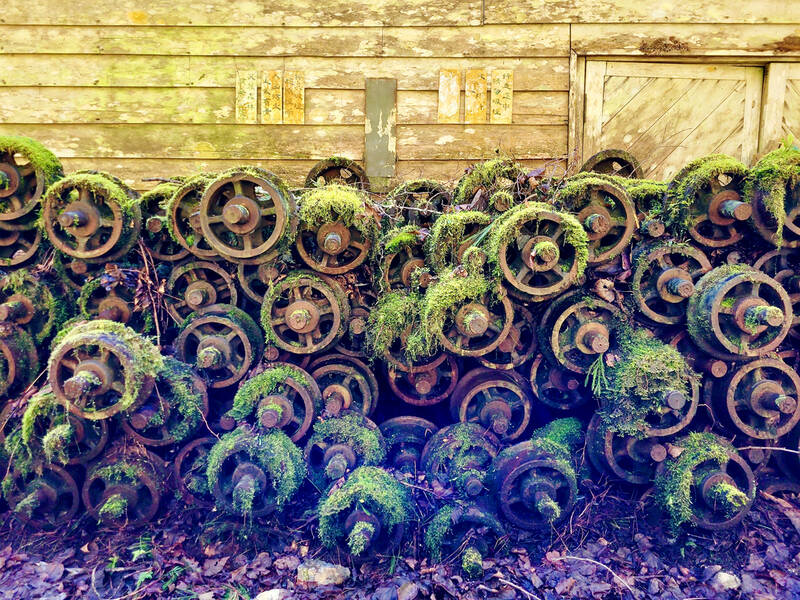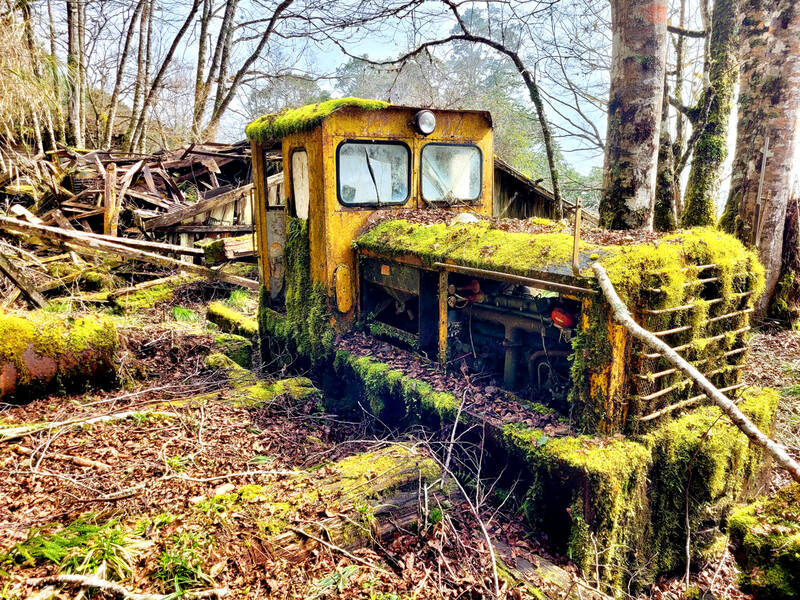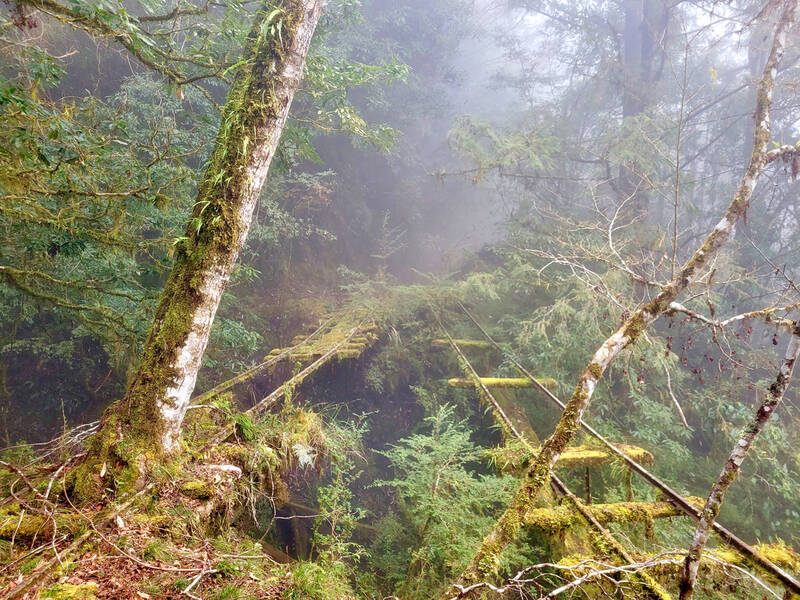On the final approach to Lanshan Workstation (嵐山工作站), logging trains crossed one last gully over a dramatic double bridge, taking the left line to enter the locomotive shed or the right line to continue straight through, heading deeper into the Central Mountains. Today, hikers have to scramble down a steep slope into this gully and pass underneath the rails, still hanging eerily in the air even after the bridge’s supports collapsed long ago.
It is the final — but not the most dangerous — challenge of a tough two-day hike in. Back when logging was still underway, it was a quick, easy ride up from Hualien City via a series of cableways and railways. Nowadays, hikers must take an alternative route along a ridge, only descending to the railway after the last impassable obstacle for the final two kilometers.
Once you finally make it to Lanshan Workstation, it is worth sticking around for at least a half-day if not a full day. The sheer size of the place and the number of buildings still standing are enough to keep you busy exploring for hours.

Photo: Tyler Cottenie
WORKING LIFE
Along the main tracks as you walk in are the buildings where people did their work at Lanshan. On the left are three partially collapsed buildings — the locomotive shed, the power plant and the lumber processing station — and a still-intact fueling station. Several locomotives are scattered in and around these buildings, still sitting on the rails where they were parked on their last working day back in 1989. Less than four meters long, with their cabs covered in flaking yellow paint and the rest in a layer of moss, these tiny logging locomotives are among the most photogenic relics at Lanshan today.
A little further ahead are some of the best-preserved buildings at the site. On the left are a concrete building and a wooden building. The former holds firefighting equipment, and thanks to its concrete walls, intact windows, and roll-up steel door that is still down and locked, the interior (as seen through a window) has been almost perfectly preserved. The adjacent wooden building was the store, and though the shelves are now bare, the handwritten labels displaying the items and their prices—canned lychee for NT$16, AA batteries for NT$3 each, men’s underwear for NT$26—make it easy to imagine what it looked like when it was operational.

Photo: Tyler Cottenie
On the opposite side of the tracks was the administrative heart of the workstation. Two staircases with a flagpole in the middle are flanked by metal signs bearing slogans encouraging workers to dedicate themselves to their logging grounds. At the top sits the blue-painted office building with its roof and walls still miraculously intact.
This space is full of interesting curiosities, like the board displaying name plates for workers, some of whom are undoubtedly still living in the lowlands, unaware that the occasional hiker still catches a glimpse of their name here, frozen in time. Also frozen in time are the work details from April of 1989, written on a chalkboard hanging on the back wall, still untouched by visitors in the decades since.
Perhaps most surprising of all is the still-intact portrait of Chiang Kai-shek (蔣介石). With the changing political climate since the 1980s, it’s hard to believe that this big smiling dictator hasn’t been the object of vandalism, but there it remains, a concrete link to Taiwan’s economically thriving but politically strained past.

Photo: Tyler Cottenie
LIFE OUTSIDE OF WORK
Traces of daily life outside of work are everywhere on the site. The center of religious life, Rongshan Temple, is right next to the office building, up a short flight of stairs. This sturdy structure’s interior is still protected from the elements, preserving the altar and decorations. The incense burner and joss paper furnace still stand outside and appear to see occasional use.
Just behind the store and firefighting equipment storage building, a fan-shaped concrete staircase leads to the lower level of the workstation. This is where workers headed after hours to eat, play and sleep.

Photo: Tyler Cottenie
Ten dormitory buildings for workers are scattered throughout this lower level, in various states of dilapidation. In those still standing, most — but not all — of the wooden floors have rotted away, and artifacts lie on the ground and in open closets everywhere: old cassette tapes, calendars, toys, clothing, furniture and more. A small bicycle and tiny shoes are evidence that some men did have their families here, while the magazine pages of nude women pinned up in other rooms suggest that some were up here on their own.
The station manager had his own personal dormitory in the southeast corner. Of note here is the portable electric heater sitting on the floor. Considering the station’s electricity was generated by burning fuel on site, the use of a high-power appliance like this was likely a privilege only accorded to the manager. The workers’ dormitories were heated only by small wood stoves, some of which are still in place.
The dining hall, bathhouses and sports field are ruined to the point that they are hard to enter, but the recreation hall is still standing. The walls on one side have fallen away and sambar deer can now enter and use this large space as their own social gathering space (and toilet).
Back when only humans gathered here, this lively space could be divided in half by a sliding door to accommodate different activities at the same time. One of the perks of working somewhere with railway access was that, despite the remoteness, large items could still be brought in, like the ping-pong table and billiards table in this hall. The original set of snooker balls and several cues are still here, and the pockets and cloth are all in decent enough shape to actually have a proper game on the table.
GETTING IN AND OUT
Getting to Lanshan Workstation from Hualien City starts with a hike up to Chuyin Mountain (初音山), one of the Small 100 Peaks. From there, you continue up the ridge to Cijiaochuan Mountain (七腳川山), sleeping at a hunter’s campsite along the way, and then descend along the ridge until you are above Tunnel No. 3. A steep forest slope on the left leads down to the rail line just as it comes out of the tunnel. Following the rail line from here takes you directly to the workstation.
However, after decades of abandonment, the rail line has suffered from numerous washouts and bridge collapses. In places, it’s possible to detour off the rail line along a narrow path that hugs the mountain wall instead of walking on a rickety old bridge. But in at least two places, the mountain is a sheer cliff, so there is no choice but to walk directly on the rotting wooden bridge. Some of the wooden beams are so rotten and mossy that it is actually safer to step directly on the slippery but solid steel rails.
This section was so unnerving that, instead of returning to Hualien along the same path, the author decided to exit via a different route, following the main railway deeper into the mountains, climbing the next ridge up to Rong Mountain (榮山) — where an old forest fire watchtower made for a lovely night’s stay — and then continuing down the opposite side to rejoin the inbound route above Tunnel No. 3.
Visiting Lanshan Workstation is an advanced four-day route with multiple risks and no maintained trail infrastructure. It should not be attempted without previous experience navigating off trail in Taiwan’s mountains, as well as redundant navigation and safety gear.
Browse the Forestry Bureau’s book Lanshan — Distant and Distinct for more information, for old photographs, or for maps that may assist in planning a visit: theme.forest.gov.tw/ebook/002/ (contains English translations).

That US assistance was a model for Taiwan’s spectacular development success was early recognized by policymakers and analysts. In a report to the US Congress for the fiscal year 1962, former President John F. Kennedy noted Taiwan’s “rapid economic growth,” was “producing a substantial net gain in living.” Kennedy had a stake in Taiwan’s achievements and the US’ official development assistance (ODA) in general: In September 1961, his entreaty to make the 1960s a “decade of development,” and an accompanying proposal for dedicated legislation to this end, had been formalized by congressional passage of the Foreign Assistance Act. Two

Despite the intense sunshine, we were hardly breaking a sweat as we cruised along the flat, dedicated bike lane, well protected from the heat by a canopy of trees. The electric assist on the bikes likely made a difference, too. Far removed from the bustle and noise of the Taichung traffic, we admired the serene rural scenery, making our way over rivers, alongside rice paddies and through pear orchards. Our route for the day covered two bike paths that connect in Fengyuan District (豐原) and are best done together. The Hou-Feng Bike Path (后豐鐵馬道) runs southward from Houli District (后里) while the

The Taipei Times last week reported that the Control Yuan said it had been “left with no choice” but to ask the Constitutional Court to rule on the constitutionality of the central government budget, which left it without a budget. Lost in the outrage over the cuts to defense and to the Constitutional Court were the cuts to the Control Yuan, whose operating budget was slashed by 96 percent. It is unable even to pay its utility bills, and in the press conference it convened on the issue, said that its department directors were paying out of pocket for gasoline

On March 13 President William Lai (賴清德) gave a national security speech noting the 20th year since the passing of China’s Anti-Secession Law (反分裂國家法) in March 2005 that laid the legal groundwork for an invasion of Taiwan. That law, and other subsequent ones, are merely political theater created by the Chinese Communist Party (CCP) to have something to point to so they can claim “we have to do it, it is the law.” The president’s speech was somber and said: “By its actions, China already satisfies the definition of a ‘foreign hostile force’ as provided in the Anti-Infiltration Act, which unlike